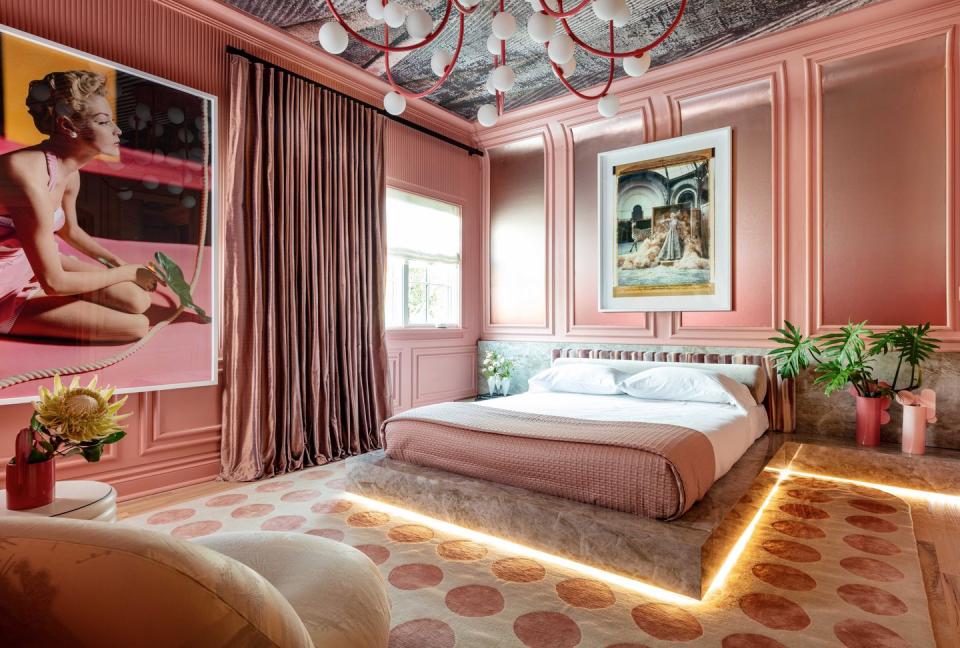Will Art Deco Make a Comeback in These Roaring 20s? Experts Weigh in

“Hearst Magazines and Verizon Media may earn commission or revenue on some items through the links below.”
Like many of us, I spent most of my pandemic days lolling about in athleisure. When it was time to take headshots earlier this spring, I knew that nothing in my closet was suitable. No, I needed something that let people know I had made it through this hellish year and that am still *very much here.* So, I treated myself to a jewel-toned sequin skirt that refracts light when I walk. It seemed like the appropriately jubilant outfit for reentry into the world. A shift towards glam is happening in the design world, too. We all joke that the Roaring Twenties never got off the ground before the pandemic hit, but here they are. It’s no surprise, then, that Art Deco is making a comeback.
"Art Deco" takes its name from the Exposition Internationale des Arts Décoratifs et Industriels Modernes, a decorative arts showcase held in Paris in 1925. There, architects and designers emerging from the first World War eschewed traditional design in favor of luxurious yet sleek elegance. It was a period of mass production and designs reflected the progress being made using new materials like reinforced concrete and stainless steel.
A feeling of optimism permeated the 1920s in the United States. While Prohibition put an (official, at least) ban on boozing, there were glamorous parties set to the tunes of the Jazz Age. Women’s dresses became more streamlined but there was plenty of glitz to be found in their accessories. (Let's not give the impression that it was all rosy, though: It’s also the era that the KKK ballooned in membership as a call for a "return to values" and pushback against young urban populations—sound familiar?)
“When I think of Art Deco design, I think of the Empire State Building. There are a lot of angles with of Art Deco,” says Nina Magon, founder of Nina Magon Studio in Houston. Defining features of the style include geometric shapes, angular lines, and even zig zags. Some consider Art Deco to be an amalgam of other styles including Cubism and global influences found in ancient Egyptian and Mesoamerican cultures which appear in ornamental details like the popular sunburst motif.
One of the most notable undercurrents of the style was the notion that anything could look beautiful, even the smallest household products, like perfume bottles. This appreciation of the impact of being surrounded by beauty is a striking parallel to the newfound interest many discovered in the aesthetics of their homes after a year of being sequestered there.
Love knowing all the latest design trends? We’ve got you covered.
Rayman Boozer, principal designer of Apartment 48, suggests that what we’re really seeing now is Postmodern, which was influenced by Art Deco. “We’re seeing a lot of curved furniture, a lot of curved lines, a lot of arches. And all of that is rooted in Art Deco,” says Boozer. “The Postmodern from the eighties was really based on Art Deco too. And those soft, soft colors, the soft pink that you see, and the dark, dark green. Those are Art Deco colors, too.”
In Asheville, architect Diana Bellgowan is experiencing a return to Deco in a quite literal way: She's in the process of readapting the S&W building into the S&W Market, a food hall. The building was designed by architect Douglas Ellington and was completed in 1928. “It’s almost a textbook version of Art Deco,” says Bellgowan. “The exterior has these really vibrant jewel-toned colors and a very geometric, triangular shape to it.” Inside, Bellgowan describes the gold ceiling as the focal point with sculptural geometric elements. “It was very much about looking modern and not trying to resemble previous styles,” says Bellgowan.
While entrenched in the style, Bellgowan has noticed other Art Deco hallmarks coming back into fashion. Metallic gold tables and lighting fixtures with opal and milk glass finishes, for starters, along with colors like peacock blue and Kelly green. “One thing I was so excited to find for this project was a Chevron-patterned cut velvet in lime green," she says. "It picked up a lot of the colors in the building and it just screams 1920s." She plans on using the fabric to upholster Deco-style lounge chairs for the bar. “The fact that those things are more readily available than they were five years ago, I think it's definitely a sign that this is a trend going forward,” she says.

In an era of luxe, velvet reigned supreme. Although it was once very luxury, it’s a material that’s en vogue right now. Says Boozer, “One thing we are seeing that's very mass market is a lot of velvet, which is a very Art Deco fabric. Those are everywhere, if you think about CB2, Pottery Barn. Everybody's doing everything in velvet."
When it comes to current iterations of the style, Magon finds that Art Deco elements add visual interest to a room—she particularly likes to layer them with modern design to add a dimension of warmth. For the Kips Bay Showhouse in Palm Beach, she designed a room that emanates Art Deco vibes with a circle-printed rug, angular wall paneling, and half moon acrylic art on one of the walls. “If that room didn't have a lot of those elements and we just painted the walls pink, then it would not have as much dimension,” says the designer.
It makes perfect sense that after a year of hiding in our shells that we would be ready to embrace Art Deco style again. The look, with its bold use of color and dynamic patterns, has happiness to it, says Bellgowan. "There is definitely is a positive thing, a sort of exuberance that Art Deco says as a style.”
And we could all use a little exuberance right now.
Follow House Beautiful on Instagram.
You Might Also Like

